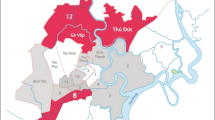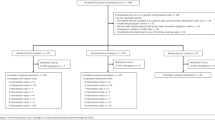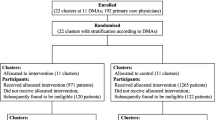Abstract
Despite clear evidence of the benefits of lowering blood pressure among patients with hypertension, the treatment rate remains <40% worldwide. In the present trial, we aimed to investigate the effects of the early promotion of clinic visits among patients with untreated hypertension detected during annual health checkups. This was a worksite-based, parallel group, cluster-randomized trial with blinded outcome assessment. Employees of 152 Japanese supermarket stores found to have untreated hypertension (blood pressure levels ≥ 160/100 mmHg) during health checkups were assigned to an early promotion group (encouraged to visit a clinic in face-to-face interviews and provided with a referral letter to a physician as well as a leaflet) or a control group (received usual care), according to random assignment. The primary outcome was the completion of a clinic visit within 6 months. Odds ratios with 95% confidence intervals for the early promotion group versus the control group were estimated using multilevel logistic regression with random effects of clusters. A total of 273 participants (mean age 50.3 years, 55% women) from 107 stores were assigned to the early promotion group (138 from 55 stores) or control group (135 from 52 stores). During the 6-month follow-up, 47 (34.1%) participants in the early promotion group visited a clinic, as did 26 (19.3%) in the control group (odds ratio 2.33, 95% confidence interval 1.12–4.84, P = 0.024). Early promotion using a referral letter during health checkups significantly increased the number of clinic visits within 6 months completed by participants with untreated hypertension (UMIN000025411).
This is a preview of subscription content, access via your institution
Access options
Subscribe to this journal
Receive 12 print issues and online access
$259.00 per year
only $21.58 per issue
Buy this article
- Purchase on Springer Link
- Instant access to full article PDF
Prices may be subject to local taxes which are calculated during checkout

Similar content being viewed by others
References
Staessen JA, Wang JG, Thijs L. Cardiovascular prevention and blood pressure reduction: a quantitative overview updated until 1 March 2003. J Hypertens. 2003;21:1055–76. https://doi.org/10.1097/00004872-200306000-00002.
Blood Pressure Lowering Treatment Trialists’ Collaboration, Turnbull F, Neal B, Pfeffer M, Kostis J, Algert C, et al. Blood pressure-dependent and independent effects of agents that inhibit the renin-angiotensin system. J Hypertens. 2007;25:951–8. https://doi.org/10.1097/HJH.0b013e3280bad9b4.
Law MR, Morris JK, Wald NJ. Use of blood pressure lowering drugs in the prevention of cardiovascular disease: meta-analysis of 147 randomised trials in the context of expectations from prospective epidemiological studies. BMJ. 2009;338:1245. https://doi.org/10.1136/bmj.b1665.
Ettehad D, Emdin CA, Kiran A, Anderson SG, Callender T, Emberson J, et al. Blood pressure lowering for prevention of cardiovascular disease and death: a systematic review and meta-analysis. Lancet. 2016;387:957–67. https://doi.org/10.1016/S0140-6736(15)01225-8.
Mills KT, Bundy JD, Kelly TN, Reed JE, Kearney PM, Reynolds K, et al. Global disparities of hypertension prevalence and control. Circulation. 2016;134:441–50. https://doi.org/10.1161/CIRCULATIONAHA.115.018912.
NCD Risk Factor Collaboration (NCD-RisC). Long-term and recent trends in hypertension awareness, treatment, and control in 12 high-income countries: an analysis of 123 nationally representative surveys. Lancet. 2019;394:639–51. https://doi.org/10.1016/S0140-6736(19)31145-6.
The Japanese Society of Hypertension. The Japanese Society of Hypertension Guidelines for the management of hypertension (JSH 2019). Tokyo, Japan: Life Science Publishing Co., Ltd.; 2019.
Satoh A, Arima H, Ohkubo T, Nishi N, Okuda N, Ae R, et al. NIPPON DATA2010 Research Group. Associations of socioeconomic status with prevalence, awareness, treatment, and control of hypertension in a general Japanese population. J Hypertens. 2017;35:401–8. https://doi.org/10.1097/HJH.0000000000001169.
Umemura S, Arima H, Arima S, Asayama K, Dohi Y, Hirooka Y, et al. The Japanese Society of Hypertension Guidelines for the management of hypertension (JSH 2019). Hypertens Res. 2019;42:1235–481.
Turin TC, Murakami Y, Miura K, Rumana N, Kita Y, Hayakawa T, et al. NIPPON DATA80/90 Research Group. Hypertension and life expectancy among Japanese: NIPPON DATA80. Hypertens Res. 2012;35:954–8. https://doi.org/10.1038/hr.2012.86.
Kobayashi A. Launch of a national mandatory chronic disease prevention program in Japan. Dis Manag Heal Outcomes. 2008;16:217–25. https://doi.org/10.2165/00115677-200816040-00003.
Kuriyama A, Takahashi Y, Tsujimura Y, Miyazaki K, Satoh T, Ikeda S, et al. Predicting failure to follow-up screened high blood pressure in Japan: a cohort study. J Public Health. 2015;37:498–505. https://doi.org/10.1093/pubmed/fdu056.
Ikegami N. Should providers be allowed to extra bill for uncovered services? Debate, resolution, and sequel in Japan. J Health Polit Policy Law. 2006;31:1129–49. https://doi.org/10.1215/03616878-2006-022.
Ikegami N, Yoo BK, Hashimoto H, Matsumoto M, Ogata H, Babazono A, et al. Japanese universal health coverage: evolution, achievements, and challenges. Lancet. 2011;378:1106–15. https://doi.org/10.1016/S0140-6736(11)60828-3.
Ministry of Health Labour and Welfare. Comprehensive Survey of Living Conditions in Japan, 2016.2017. https://www.mhlw.go.jp/toukei/saikin/hw/k-tyosa/k-tyosa16/. Accessed 9 March 2020.
Hino Y, Kan H, Minami M, Takada M, Shimokubo N, Nagata T, et al. The challenges of occupational health service centers in Japan. Ind Health. 2006;44:140–3. https://doi.org/10.2486/indhealth.44.140.
Suka M, Odajima T, Okamoto M, Sumitani M, Nakayama T, Sugimori H. Reading comprehension of health checkup reports and health literacy in Japanese people. Environ Health Prev Med. 2014;19:295–306. https://doi.org/10.1007/s12199-014-0392-8.
Meng L, Zhao D, Pan Y, Ding W, Wei Q, Li H, et al. Validation of Omron HBP-1300 professional blood pressure monitor based on auscultation in children and adults. BMC Cardiovasc Disord. 2016;16:9. https://doi.org/10.1186/s12872-015-0177-z.
White WB, Anwar YA. Evaluation of the overall efficacy of the Omron office digital blood pressure HEM-907 monitor in adults. Blood Press Monit. 2001;6:107–10.
Erfurt JC, Foote A, Heirich MA. Worksite wellness programs: incremental comparison of screening and referral alone, health education, follow-up counseling, and plant organization. Am J Health Promot. 1991;5:438–48. https://doi.org/10.4278/0890-1171-5.6.438.
Velez R, Anderson L, McFall S, Magruder-Habib K. Improving patient follow-up in incidental screening through referral letters. Arch Intern Med. 1985;145:2184–7. https://doi.org/10.1001/archinte.1985.00360120052008.
Krieger J, Collier C, Song L, Martin D. Linking community-based blood pressure measurement to clinical care: a randomized controlled trial of outreach and tracking by community health workers. Am J Public Health. 1999;89:856–61. https://doi.org/10.2105/ajph.89.6.856.
Jones PK, Jones SL, Katz J. Improving follow-up among hypertensive patients using a health belief model intervention. Arch Intern Med. 1987;147:1557–60. https://doi.org/10.1001/archinte.1987.00370090037007.
Hanai Y, Tabuse Y, Nishikawa A, Aiba O, Tsuboi M, Tsuchiya E, et al. Increase in examination rate for secondary testing due to improved guidance and future issues. Ningen Dock. 2017;32:2012–7.
Ministry of Health Labour and Welfare. Report on regional public health services and health promotion services. https://www.mhlw.go.jp/toukei/saikin/hw/c-hoken/17/dl/gaikyo.pdf. 2017. Accessed 9 Mar 2020.
Goldbeck R. Denial in physical illness. J Psychosom Res. 1997;43:575–93. https://doi.org/10.1016/S0022-3999(97)00168-2.
Jokisalo E, Kumpusalo E, Enlund H, Takala J. Patients’ perceived problems with hypertension and attitudes towards medical treatment. J Hum Hypertens. 2001;15:755–61. https://doi.org/10.1038/sj.jhh.1001276.
Phillips LS, Branch WT, Cook CB, Doyle JP, El-Kebbi IM, Gallina DL, et al. Clinical inertia. Ann Intern Med. 2001;135:825–34. https://doi.org/10.7326/0003-4819-135-9-200111060-00012.
Josiah Willock R, Miller JB, Mohyi M, Abuzaanona A, Muminovic M, Levy PD. Therapeutic inertia and treatment intensification. Curr Hypertens Rep. 2018;20:4. https://doi.org/10.1007/s11906-018-0802-1.
Harle CA, Harman JS, Yang S. Physician and patient characteristics associated with clinical inertia in blood pressure control. J Clin Hypertens. 2013;15:820–4. https://doi.org/10.1111/jch.12179.
Wang Z, Wang X, Shen Y, Li S, Chen Z, Zheng C, et al. China Hypertension Survey Group: The Standardized Management of Hypertensive Employees Program. Effect of a workplace-based multicomponent intervention on hypertension control: a randomized clinical trial. JAMA Cardiol. 2020:1–9. https://doi.org/10.1001/jamacardio.2019.6161.
Ohkubo T, Imai Y, Tsuji I, Nagai K, Kato J, Kikuchi N, et al. Home blood pressure measurement has a stronger predictive power for mortality than does screening blood pressure measurement: a population-based observation in Ohasama, Japan. J Hypertens. 1998;16:971–5. https://doi.org/10.1097/00004872-199816070-00010.
Whelton PK, Carey RM, Aronow WS, Casey DE Jr, Collins KJ, Dennison Himmelfarb C, et al. 2017 ACC/AHA/AAPA/ABC/ACPM/AGS/APhA/ASH/ASPC/NMA/PCNA guideline for the prevention, detection, evaluation, and management of high blood pressure in adults: executive summary: a report of the American College of Cardiology/American Heart Association Task Force on Clinical Practice Guidelines. J Am Soc Hypertens. 2018;12:579.e1–73. https://doi.org/10.1016/j.jash.2018.06.010.
Mori H, Ukai H, Yamamoto H, Saitou S, Hirao K, Yamauchi M, et al. Current status of antihypertensive prescription and associated blood pressure control in Japan. Hypertens Res. 2006;29:143–51. https://doi.org/10.1291/hypres.29.143.
Hozawa A, Kuriyama S, Shimazu T, Ohmori-Matsuda K, Tsuji I. Seasonal variation in home blood pressure measurements and relation to outside temperature in Japan. Clin Exp Hypertens. 2011;33:153–8. https://doi.org/10.3109/10641963.2010.531841.
Ministry of Health, Labour and Welfare of Japan, National Federation of Health Insurance Societies of Japan. Data health planning guide (revised version). 2017. https://www.mhlw.go.jp/file/06-Seisakujouhou-12400000-Hokenkyoku/0000201969.pdf. Accessed Sep 20 2019.
Acknowledgements
The authors are deeply indebted to Dr. Shoji Tabata, the staff of Ishikawa-ken Health Service Association, and the staff of Foundation of General Incorporated Foundation Kinki Health Administration Center for their excellent support. We also thank all members of Heiwado Health Insurance Society and Heiwado Occupational Health Care Office, especially Ms. Atsuko Kawamura for her careful coordination of the staff administering the health checkups. We thank Analisa Avila, ELS, of Edanz Group (https://en-author-services.edanzgroup.com/) for editing a draft of this paper.
Funding
This study was partly supported by a Grant-in-Aid for Scientific Research (Grant number 17K17539) from the Ministry of Education, Culture, Sports, Science and Technology of Japan.
Author information
Authors and Affiliations
Corresponding author
Ethics declarations
Conflict of interest
Three authors (AS, AM, and YK) are salaried employees of the retail company where the present study was conducted. The other authors declare no conflicts of interest.
Additional information
Publisher’s note Springer Nature remains neutral with regard to jurisdictional claims in published maps and institutional affiliations.
Supplementary information
Rights and permissions
About this article
Cite this article
Shima, A., Arima, H., Miura, K. et al. Cluster-randomized controlled trial for the early promotion of clinic visits for untreated hypertension. Hypertens Res 44, 355–362 (2021). https://doi.org/10.1038/s41440-020-00559-0
Received:
Revised:
Accepted:
Published:
Issue Date:
DOI: https://doi.org/10.1038/s41440-020-00559-0



